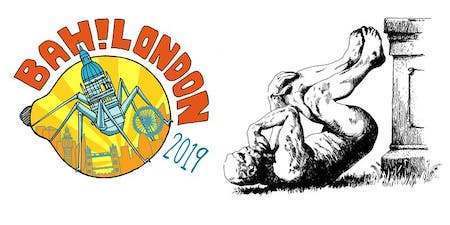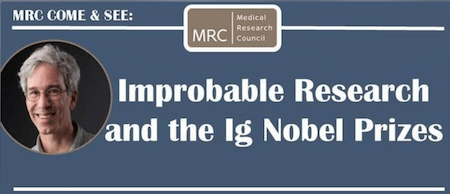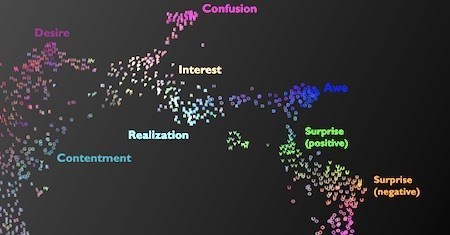Marc Abrahams's Blog, page 154
March 19, 2019
Inspired, he did do-it-yourself-endoscopy [video]
The gentleman in this video writes: “September 2018 Japanese doctor wins Ig Nobel prize for do-it-yourself colonoscopy. I tried another examination, Trans nasal Endoscopy (do-it-myself)”
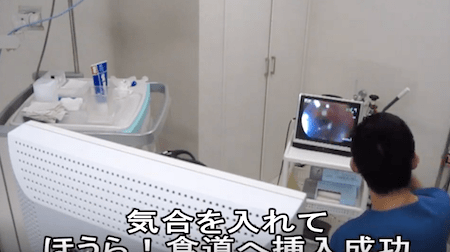

March 18, 2019
Four people doing what with beer bottles?
What are these people doing with these beer bottles? Come to the Ig Nobel show at the University of Graz, on Tuesday, March 19, 2019, at 6:00 pm, and the answer might become clear.
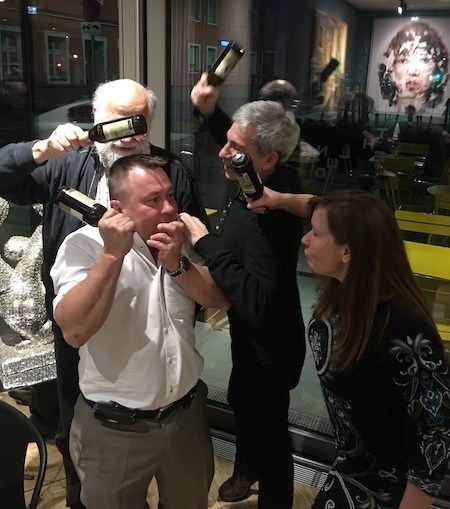
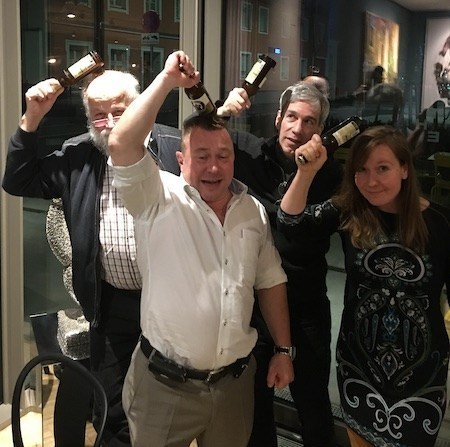

Predicting the stock market from photographs in the financial-press (new study)
 If you’re inclined to make bets on the stock market, you’ll be at a considerable disadvantage if you don’t have a tight grip on so called ‘investor sentiment’ – in other words a reliable way of being able to judge the current ‘mood’ of the market. But, in practice, it’s notoriously difficult to gauge accurately. A team from Missouri State University, US, have come up with a novel method. Why not just analyse photos in the financial press to see if people look happy (or not) ? They’re calling it ‘Photo Sentiment’.
If you’re inclined to make bets on the stock market, you’ll be at a considerable disadvantage if you don’t have a tight grip on so called ‘investor sentiment’ – in other words a reliable way of being able to judge the current ‘mood’ of the market. But, in practice, it’s notoriously difficult to gauge accurately. A team from Missouri State University, US, have come up with a novel method. Why not just analyse photos in the financial press to see if people look happy (or not) ? They’re calling it ‘Photo Sentiment’.
The researchers say that their machine-learning algorithms, which analysed photos in The Economist (that had been published over a period of 10 years) out-performed other more traditional methods by 2.6%.
“Photo Sentiment is found to predict short-term return reversal, trading volume and market volatility, and explain flows between equity and money market funds. A trading strategy based on Photo Sentiment outperforms the market index by 2.6% on an annual basis while assuming less risk.”
See: Obaid, Khaled and Pukthuanthong, Kuntara, A Picture Is Worth a Thousand Words: Market Sentiment From Photos (December, 2018). Available at SSRN
The Economist cover above is from July 1998

Tuesday: Ig Nobel in Graz!
Tuesday evening, the Ig Nobel EuroTour arrives at Karl Franzens University, in Graz—featuring psychos, beer, and peeing dogs:
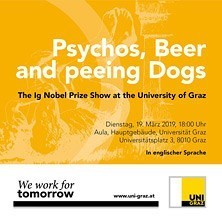 March 19, Tuesday, 6:00 pm—University of Graz, Austria, at —TICKETS TICKETS TICKETS—The show will be conducted (almost) entirely in the English language—Marc Abrahams and
March 19, Tuesday, 6:00 pm—University of Graz, Austria, at —TICKETS TICKETS TICKETS—The show will be conducted (almost) entirely in the English language—Marc Abrahams and
Ig Nobel Prize winner Minna Lyons (Comparison of psychopathic traits in night owls versus early risers)
Ig Nobel Prize winner Hynek Burda (Free-roaming dogs, when urinating, align themselves with earth’s magnetic lines)
Ig Nobel Prize winner Stephan Bolliger (Is it better to be hit on the head with a full bottle of beer, or a with an empty bottle of beer?)
Tour Subsequent Events
After that, the Ig Nobel EuroTour will move on to The Czech Republic, Switzerland, The Netherlands, Poland, Italy, Sweden, Norway, Germany, and Italy (again).

March 15, 2019
SATURDAY: Ig Nobel at Imperial College London, paired with BAHFest!
Saturday afternoon The Ig Nobel EuroTour arrives at Imperial College London:
March 16, Saturday, 3:00 pm—Imperial College London, UK, in the Great Hall—This is the first half of a special double-event day, together with BAHFest London (BAHFest begins at 7:00 pm). TICKETS TICKETS TICKETS are on sale; there is the option to purchase tickets for both events, or for just one.]—Marc Abrahams and
Ig Nobel Prize winner James Heathcote (Why do old men have big ears?)
Ig Nobel Prize winners Alex Garcia-Faura (Vagina music, for fetuses)
Robert Ewers (Boring Speakers Talk for Longer)
Ig Nobel Prize winner James Cole (Nutritional value of human cannibalism)
Andrew George (British premiere performance of the chorus-enhanced version of William Topaz McGonagall ‘s ‘disastrous poem “The Tay Bridge Disaster”), with Ig Nobel Prize winner Chris McManus (Scrotal asymmetry in man and in ancient sculpture), members of the London Sea Shanty Collective , and other stars
Both these events will (probably) be livestreamed on the Imperial College Youtube channel.
Tour Subsequent Events
After that, the Ig Nobel EuroTour will move on to Austria, The Czech Republic, Switzerland, The Netherlands, Poland, Italy, Sweden, Norway, Germany, and Italy (again).

Smell-and-Hair and Sounds-and-Cheese Experiments
Smells have effects on hair follicles and sounds have effects on the taste of cheese, sometimes, suggest two recent—but not necessarily related studies.
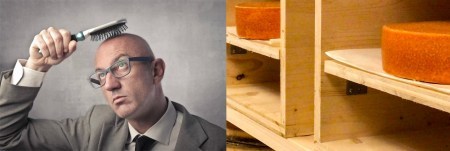
The sound-and-hair study is described in LiveScience (thanks to Francesca Bewer for bringing this to our attention):
Like your nose, your hair can detect odors. In a new study, researchers found that hair follicles contain olfactory receptors — the same kind of chemical receptors that lie deep in the nasal passages. In the nose, these receptors bind to odor molecules that waft in, sending signals to your brain to alert you that something reeks — or smells delicious.
What’s more, the researchers found, these hair-follicle receptors can be activated by synthetic sandalwood to stimulate hair growth, according to the study, published Sept. 18 in the journal Nature Communications….
The sound-and-cheese experiment is described, so far as we are aware, only in press accounts. (Thanks to Reto Schneider for bringing those to our attention.) The SwissInfo web site says:
A quirky experiment that exposed Swiss cheese to different kinds of music found that hip-hop made it taste the best.
Eight wheels of “Muttenglück” Emmental cheese from World Cheese Championship winner Antony Wyss were subjected separately to different musical stimulus – Mozart, A Tribe Called Quest, Yello, Led Zeppelin, techno and three sinusoidal sounds – round-the-clock for eight months. The experiment was part of a collaboration between students of the University of Arts Bern and veterinarian Beat Wampfler who came up with the idea…..

March 14, 2019
Skull-Penetration Interventions to Combat Zombies
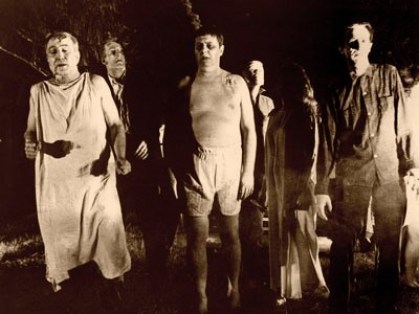 An article in the Journal of Neuroscience Nursing, February 2019, Volume :51 Number 1, discusses the question of evidence in assessing traumatic brain injuries (TBI) by using the example of Zombies.
An article in the Journal of Neuroscience Nursing, February 2019, Volume :51 Number 1, discusses the question of evidence in assessing traumatic brain injuries (TBI) by using the example of Zombies.
The article begins :
“Despite anecdotal evidence seen on television and in movies, there is zero actual research to support penetrating traumatic brain injury (TBI) as an intervention to kill zombies (eg, walkers). For the moment, we shall dispense with the obvious conundrum that one cannot kill (end the life of) someone or something that is already dead. Rather, we shall focus on the concept of evidence.”
And concludes :
“Again, it can be noted that there are difficulties involved with evidence collection regarding the issue of the definition of death on a nonliving being. Perhaps, the limitation is that this is not an intervention with adequate preclinical data, or perhaps the theory is flawed. Because of the lack of research data, the only evidence available is expert opinion. Thus, we conclude that, if we were attacked by a horde of walkers, our best evidence-based practice option would be to use a skull-penetration intervention (class of evidence, level IIB; strength of recommendation, level C).”
It can be read, in full, here : Of Zombies and Evidence
The photo is a still from the film ‘Night of the Living Dead’, 1968.
[ Research research by Martin Gardiner ]

March 12, 2019
Ig Nobel – Wednesday at U of Manchester
UPDATE: This has been moved to a larger venue: It will be held in the Simon Building.
Wednesday, March 13, 2019 the Ig Nobel EuroTour arrives at the University of Manchester, UK—in the Simon Building, Brunswick St, on the corner with Oxford Road).
Marc Abrahams will do 2 events:
2 pm, in room Room 2.60—Workshop [for MRC doctoral students] about “how to decide what is important and what’s not, and what’s real and what not”.
4 pm, in Lecture Theatre B—A talk [open to everyone] about “Improbable Research and the Ig Nobel Prizes“, preceded by tea, coffee, and cake at 3:30). TICKETS TICKETS TICKETS are free (but limited in number).
Tour Subsequent Events
After that, the Ig Nobel EuroTour will move on to Imperial College London (on Saturday afternoon, March 16), and then to Austria, The Czech Republic, Switzerland, The Netherlands, Poland, Italy, Sweden, Norway, Germany, and Italy (again).

Interactive map of grunts, groans, sighs and other sounds
A surprisingly vocal map of human sounds and emotions now exists online. This map is not a geographical map, it is a noisy map:
The map, and the whats and wheres of it, get a detailed description in the study “Mapping 24 emotions conveyed by brief human vocalization,” Alan S. Cowen, Hillary Anger Elfenbein, Petri Laukka, and Dacher Keltner, American Psychologist, epub 2018.
The Linguistic Society of America has a seemingly lengthy writeup about it, including lots of words but no actual sounds.
Open Culture has a nice writeup about it, including a nice picture of the map, unremarkably similar to the map you see here.
(Thanks to Estrella Burgos for bringing this to our attention.)

March 11, 2019
Banana skins and rabbit cartilage mucus – with an Ig Nobel connection
Kiyoshi Mabuchi, Kensei Tanaka, Daichi Uchijima and Rina Sakai, were jointly awarded the 2014 Ig Nobel Physics Prize for measuring the amount of friction between a shoe and a banana skin, and between a banana skin and the floor, when a person steps on a banana skin that’s on the floor.
REFERENCE: “Frictional Coefficient under Banana Skin,”, Kiyoshi Mabuchi, Kensei Tanaka, Daichi Uchijima and Rina Sakai, Tribology Online 7, no. 3, 2012, pp. 147-151.
Subsequently, in 2016, the team gave a detailed account of how their research work into slipperiness developed, how it lead to the Ig Nobel Prize, and then on to studies of rabbit tibia cartilage mucous.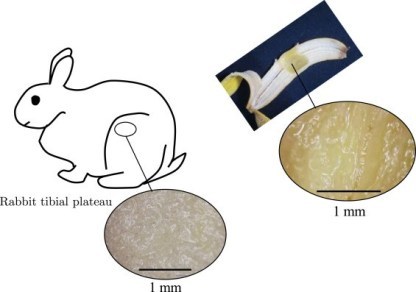
“After receiving the Ig Nobel Prize, I looked back on the initiation of my research on banana peels, and discussed the association between joint lubrication and the slipperiness of banana peels again. I recognized the fact that mucus plays the primary role in both of them.”
The team’s open-access paper can be read in full here : ‘Ig Nobel Prize-winning episode: Trip from a slip on a banana peel to the mysterious world of mucus’ in Biosurface and Biotribology, Volume 2, Issue 3, September 2016, Pages 81-85
[ Research research by Martin Gardiner ]

Marc Abrahams's Blog
- Marc Abrahams's profile
- 14 followers


